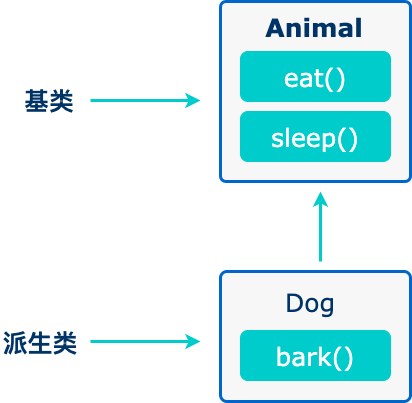一、继承的定义
1.继承指的是:我们依据另一个类来定义类;当创建类时,不需要重新编写新的数据成员和成员函数,只需指定新建的类继承了一个已有的类的成员即可。
这个已有的类称为基类,新建的类称为派生类。
2.继承的好处:这使得创建和维护一个应用程序变得更容易,也达到了重用代码功能和提高执行效率的效果。
例如,哺乳动物是动物,狗是哺乳动物,因此,狗是动物,等等

// 基类 class Animal { // eat() 函数 // sleep() 函数 }; //派生类 class Dog : public Animal { // bark() 函数 };
二、基类、派生类的访问限制
派生类可以访问基类中所有的非私有成员,声明为 private的成员不能被派生类的成员函数访问
一个派生类继承了所有的基类方法,但下列情况除外:
- 基类的构造函数、析构函数和拷贝构造函数。
- 基类的重载运算符。
- 基类的友元函数。
三、派生类的类型
当一个类派生自基类,该基类可以被继承为 public、protected 或 private 几种类型
我们几乎不使用 protected 或 private 继承,通常使用 public 继承
四、继承类型
1.公有继承(public):当一个类派生自公有基类时
基类的公有成员也是派生类的公有成员
基类的保护成员也是派生类的保护成员
基类的私有成员不能直接被派生类访问,但是可以通过调用基类的公有和保护成员来访问
2.保护继承(protected): 当一个类派生自保护基类时
基类的公有和保护成员将成为派生类的保护成员
3.私有继承(private):当一个类派生自私有基类时
基类的公有和保护成员将成为派生类的私有成员
五、多继承
一个子类可以有多个父类,它继承了多个父类的特性
实例:
#include <iostream> using namespace std; // 基类 Shape class Shape { public: void setWidth(int w) { width = w; } void setHeight(int h) { height = h; } protected: int width; int height; }; // 基类 PaintCost class PaintCost { public: int getCost(int area) { return area * 70; } }; // 派生类 class Rectangle: public Shape, public PaintCost { public: int getArea() { return (width * height); } }; int main(void) { Rectangle Rect; int area; Rect.setWidth(5); Rect.setHeight(7); area = Rect.getArea(); // 输出对象的面积 cout << "Total area: " << Rect.getArea() << endl; // 输出总花费 cout << "Total paint cost: $" << Rect.getCost(area) << endl; return 0; }
当上面的代码被编译和执行时,它会产生下列结果:
Total area: 35
Total paint cost: $2450